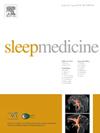Cardiovascular burden of individuals diagnosed with idiopathic hypersomnia: Real-World Idiopathic Hypersomnia Total Health Model (CV-RHYTHM)
IF 3.4
2区 医学
Q1 CLINICAL NEUROLOGY
引用次数: 0
Abstract
Objective/background
Limited research assesses cardiovascular risk in people with idiopathic hypersomnia. This study compared cardiovascular conditions or events among individuals with idiopathic hypersomnia with those among matched non–idiopathic hypersomnia controls.
Patients/methods
Claims from Merative™ MarketScan® Research Databases (12/2013–2/2020) were analyzed. Eligible individuals with idiopathic hypersomnia were ≥18 years of age upon cohort entry, continuously enrolled for 365 days before and after cohort entry (gaps ≤30 days allowed), and without cataplexy. Individuals with idiopathic hypersomnia entered the cohort upon their earliest medical claim with an idiopathic hypersomnia diagnosis code. Controls were matched 5:1, without replacement, to individuals with idiopathic hypersomnia using demographic characteristics. Odds of prevalent cardiovascular conditions or events during the 2-year assessment period (365 days before and after cohort entry date) were compared using unconditional logistic regression. Results were reported as odds ratios (ORs) with 95 % confidence intervals (CIs).
Results
Final cohorts included 11,412 individuals with idiopathic hypersomnia and 57,058 matched controls. Odds (OR, 95 % CI) of cardiovascular disease (2.26, 2.14–2.38), major adverse cardiovascular event (2.08, 1.89–2.30), stroke (2.07, 1.87–2.29), hypertension diagnosis or antihypertensive use (2.02, 1.93–2.12), heart failure (1.97, 1.76–2.20), atrial fibrillation (1.91, 1.66–2.20), myocardial infarction (1.74, 1.42–2.12), and coronary revascularization (1.58, 1.12–2.17) were higher in individuals with idiopathic hypersomnia than matched controls.
Conclusions
Individuals with idiopathic hypersomnia had higher odds of prevalent cardiovascular conditions or events than matched controls. These results reinforce that clinicians should be aware of patients’ cardiovascular risk profiles when selecting idiopathic hypersomnia treatments.

特发性嗜睡症患者的心血管负担:真实世界特发性嗜睡症总健康模型(CV-RHYTHM)
目的/背景有限的研究评估了特发性嗜睡患者的心血管风险。本研究比较了特发性嗜睡患者与匹配的非特发性嗜睡对照组的心血管疾病或事件。对来自Merative™MarketScan®研究数据库(2013年12月- 2020年2月)的患者/方法进行分析。符合条件的特发性嗜睡患者入组时年龄≥18岁,入组前后连续入组365天(间隔≤30天),且无猝厥。患有特发性嗜睡症的个体根据其最早的医疗声明和特发性嗜睡症诊断代码进入队列。根据人口统计学特征,对照与特发性嗜睡症患者的比例为5:1,无替代。在2年评估期间(队列进入日期前后365天),使用无条件逻辑回归比较流行心血管疾病或事件的几率。结果以95%置信区间(ci)的优势比(ORs)报告。最终的队列包括11,412名特发性嗜睡症患者和57,058名匹配的对照组。特发性嗜睡患者的心血管疾病(2.26,2.14-2.38)、主要心血管不良事件(2.08,1.89-2.30)、卒中(2.07,1.87-2.29)、高血压诊断或降压药使用(2.02,1.93-2.12)、心力衰竭(1.97,1.76-2.20)、房颤(1.91,1.66-2.20)、心肌梗死(1.74,1.42-2.12)和冠状动脉血流量重建术(1.58,1.12-2.17)的比值(OR, 95% CI)高于对照组。结论:与对照组相比,特发性嗜睡患者患心血管疾病或事件的几率更高。这些结果强化了临床医生在选择特发性嗜睡症治疗方法时应了解患者的心血管风险概况。
本文章由计算机程序翻译,如有差异,请以英文原文为准。
求助全文
约1分钟内获得全文
求助全文
来源期刊

Sleep medicine
医学-临床神经学
CiteScore
8.40
自引率
6.20%
发文量
1060
审稿时长
49 days
期刊介绍:
Sleep Medicine aims to be a journal no one involved in clinical sleep medicine can do without.
A journal primarily focussing on the human aspects of sleep, integrating the various disciplines that are involved in sleep medicine: neurology, clinical neurophysiology, internal medicine (particularly pulmonology and cardiology), psychology, psychiatry, sleep technology, pediatrics, neurosurgery, otorhinolaryngology, and dentistry.
The journal publishes the following types of articles: Reviews (also intended as a way to bridge the gap between basic sleep research and clinical relevance); Original Research Articles; Full-length articles; Brief communications; Controversies; Case reports; Letters to the Editor; Journal search and commentaries; Book reviews; Meeting announcements; Listing of relevant organisations plus web sites.
 求助内容:
求助内容: 应助结果提醒方式:
应助结果提醒方式:


